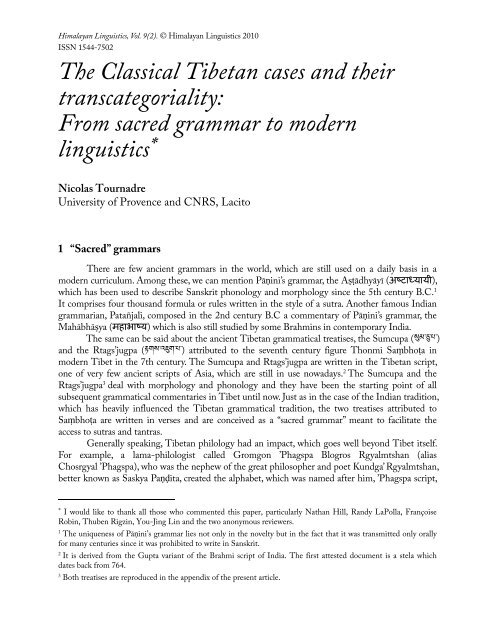The Classical Tibetan cases and their transcategoriality
The Classical Tibetan cases and their transcategoriality
The Classical Tibetan cases and their transcategoriality
You also want an ePaper? Increase the reach of your titles
YUMPU automatically turns print PDFs into web optimized ePapers that Google loves.
Himalayan Linguistics, Vol. 9(2). © Himalayan Linguistics 2010<br />
ISSN 1544-7502<br />
<strong>The</strong> <strong>Classical</strong> <strong>Tibetan</strong> <strong>cases</strong> <strong>and</strong> <strong>their</strong><br />
<strong>transcategoriality</strong>:<br />
From sacred grammar to modern<br />
linguistics ∗<br />
Nicolas Tournadre<br />
University of Provence <strong>and</strong> CNRS, Lacito<br />
1 “Sacred” grammars<br />
<strong>The</strong>re are few ancient grammars in the world, which are still used on a daily basis in a<br />
modern curriculum. Among these, we can mention Pāṇini’s grammar, the Aṣṭādhyāyī (अटायायी),<br />
which has been used to describe Sanskrit phonology <strong>and</strong> morphology since the 5th century B.C. 1<br />
It comprises four thous<strong>and</strong> formula or rules written in the style of a sutra. Another famous Indian<br />
grammarian, Patañjali, composed in the 2nd century B.C a commentary of Pāṇini’s grammar, the<br />
Mahābhāṣya (महाभाय) which is also still studied by some Brahmins in contemporary India.<br />
<strong>The</strong> same can be said about the ancient <strong>Tibetan</strong> grammatical treatises, the Sumcupa (སུམ་ཅུ་པ་)<br />
<strong>and</strong> the Rtags’jugpa (རྟགས་འཇུག་པ་) attributed to the seventh century figure Thonmi Saṃbhoṭa in<br />
modern Tibet in the 7th century. <strong>The</strong> Sumcupa <strong>and</strong> Rtags’jugpa are written in the <strong>Tibetan</strong> script,<br />
one of very few ancient scripts of Asia, which are still in use nowadays. 2 <strong>The</strong> Sumcupa <strong>and</strong> the<br />
Rtags’jugpa 3 deal with morphology <strong>and</strong> phonology <strong>and</strong> they have been the starting point of all<br />
subsequent grammatical commentaries in Tibet until now. Just as in the case of the Indian tradition,<br />
which has heavily influenced the <strong>Tibetan</strong> grammatical tradition, the two treatises attributed to<br />
Saṃbhoṭa are written in verses <strong>and</strong> are conceived as a “sacred grammar” meant to facilitate the<br />
access to sutras <strong>and</strong> tantras.<br />
Generally speaking, <strong>Tibetan</strong> philology had an impact, which goes well beyond Tibet itself.<br />
For example, a lama-philologist called Gromgon ’Phagspa Blogros Rgyalmtshan (alias<br />
Chosrgyal ’Phagspa), who was the nephew of the great philosopher <strong>and</strong> poet Kundga’ Rgyalmtshan,<br />
better known as Saskya Paṇḍita, created the alphabet, which was named after him, ’Phagspa script,<br />
∗ I would like to thank all those who commented this paper, particularly Nathan Hill, R<strong>and</strong>y LaPolla, Françoise<br />
Robin, Thuben Rigzin, You-Jing Lin <strong>and</strong> the two anonymous reviewers.<br />
1 <strong>The</strong> uniqueness of Pāṇini’s grammar lies not only in the novelty but in the fact that it was transmitted only orally<br />
for many centuries since it was prohibited to write in Sanskrit.<br />
2 It is derived from the Gupta variant of the Brahmi script of India. <strong>The</strong> first attested document is a stela which<br />
dates back from 764.<br />
3 Both treatises are reproduced in the appendix of the present article.
















